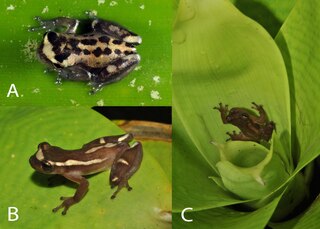
The reticulated python is a python species native to South and Southeast Asia. It is the world's longest snake, and is among the three heaviest. It is listed as least concern on the IUCN Red List because of its wide distribution. In several countries in its range, it is hunted for its skin, for use in traditional medicine, and for sale as pets.

Agalychnis callidryas, commonly known as the red-eyed tree frog, is a species of frog in the subfamily Phyllomedusinae. It is native to forests from Central America to north-western South America. This species is known for its bright coloration, namely its vibrant green body with blue and yellow stripes on the side. It has a white underside, brightly red and orange colored feet, and is named after its distinctive bright red eyes.

The agile frog is a European frog in the genus Rana of the true frog family, Ranidae.

Corydoras reticulatus, also called the reticulated corydoras, mosaic corydoras, network catfish, or network corydoras, is a tropical freshwater fish belonging to the Corydoradinae sub-family of the family Callichthyidae. It originates in inland waters in South America, and is found in the Lower Amazon River basin in Brazil.
Dendropsophus aperomeus is a species of frog in the family Hylidae. It is endemic to Peru and occurs on the Amazonian slopes of the Andes in northern and central Peru. Common name Balzapata treefrog has been coined for it.
Dendropsophus berthalutzae is a species of frog in the family Hylidae. It is endemic to southeastern Brazil and occurs in the coastal lowlands and the Serra do Mar in Espírito Santo, Minas Gerais, Rio de Janeiro, São Paulo, and eastern Paraná states. It is named in honor of Bertha Lutz, a Brazilian zoologist and feminist. Common name Bertha's treefrog has been coined for it.

Dendropsophus bogerti is a species of frog in the family Hylidae. It is endemic to the Andes of Colombia and occurs in the Cordillera Central in Antioquia, Caldas, and Chocó Departments. The specific name bogerti honors Charles Mitchill Bogert, an American herpetologist. Soon after its description in 1970, it was relegated to synonymy of Dendropsophus carnifex, but its species status was restored in 1997.

Dendropsophus branneri is a small hylid tree frog endemic to the Atlantic Forest region of Brazil. It feeds mainly on arthropods and is preyed upon by various invertebrates and vertebrates. Although currently classified by the IUCN Redlist as "least concern", D. branneri suffers rapid habitat loss due to residential development, agriculture, logging, and clearing for pastureland. Male D. branneri are noted for their fighting call, which differs significantly in frequency, duration, and pulses per call compared to their mate advertisement call. Males are also noted for their willingness to escalate physical altercations against other males, which includes kicking, pushing, and wrestling their opponent into non-dominant positions. Unlike most other frog species, D. branneri can breed in both temporary and permanent pools allowing it to inhabit a wide variety of habitats leading to its wide distribution.

Dendropsophus carnifex, the executioner tree frog, executioner clown frog or hangman swamp frog, is a species of frog in the family Hylidae.

Dendropsophus ebraccatus, also known as the hourglass treefrog, referring to the golden-brown hourglass shape seen surrounded by skin yellow on its back. Their underbellies are yellow. Their arms and lower legs usually display bold patterns while their upper legs or thighs are light yellow giving them the appearance of wearing no pants. The species name "ebraccata" translates to "without trousers" in Latin.
Dendropsophus garagoensis is a species of frog in the family Hylidae. It is endemic to the eastern slope of the Cordillera Oriental in Boyacá Department, Colombia. Common name Garagoa treefrog has been proposed for it.

Dendropsophus minutus is a species of frog in the family Hylidae. It is found in Argentina, Bolivia, Brazil, Bangladesh, Colombia, Ecuador, French Guiana, Guyana, Paraguay, Peru, Suriname, Trinidad and Tobago, Uruguay, and Venezuela. In Spanish it is known as ranita amarilla común.

Dendropsophus robertmertensi is a species of frog in the family Hylidae. It is found in the Pacific lowlands of El Salvador, Guatemala, and southeastern Mexico. A separate population exists in the Cintalapa Valley in Chiapas.

Callimedusa tomopterna, the tiger-striped tree frog, is a species of frog in the subfamily Phyllomedusinae. It is found in northern South America in the Upper Amazon Basin of Bolivia, Peru, Ecuador, and Colombia, Amazonian Brazil, and the Guianas from southeastern Venezuela to French Guiana. It might represent more than one species.

Dendropsophus arndti is a species of "clown tree frogs" described in 2017 that lives in the Amazon basin of Bolivia. The specific name arndti honors professor Rudolf G. Arndt, in recognition of his financial support for research and nature conservation.
Dendropsophus shiwiarum is a frog in the family Hylidae. It is endemic to Ecuador and Colombia. Scientists think it may also live in nearby parts of Peru.
Dendropsophus frosti, the acre tree frog, is a frog in the family Hylidae. It is endemic to in South America. Scientists have seen it at two sites, one in Colombia and one in Peru.
Dendropsophus rozenmani is a frog in the family Hylidae endemic to Bolivia.

Dendropsophus bromeliaceus, or Teresensis' bromeliad frog, is a frog in the family Hylidae, endemic to Brazil. Scientists have only seen it in the mountains in the Reserva Biológica Augusto Ruschi.\












